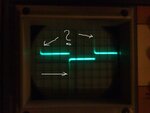Windmiller
Member level 4
Hello!
I bought myself an oscilloscop in secondhand and it was a GOS-3110 which I do belive is the same as the NRI-2500. It is a 10Mhz oscilloscope, and when I tested it the first time everything seemed ok with the wave in the middle of the screen. But as the time went on doing some test measurements the wave started slowly to descend until it was off screen, and I tried to bring it back by turning the vertical pot but nothing happend. Even if I turn it off and on, the wave is still far beyond off screen which I can see if I turn the V nob to 5mV and give it more input then I can see the top part of the wave.
From the beginning I was using my homemade 1X probe, made from schematics on this site.. How to Build Your Own Oscilloscope Probes and this was working at first but slowly descending and to not work anymore soo I went over to direct input the lineout from the computer with some music.
I've tried to connect music line out to the input of the oscilloscope, and I can see the top of the wave once again. But not able to bring the wave upp on screen.
What could it be? There's no more nobs to turn, and I've ran out of options because I can't find anything similar on the web, and no manual. I've just found the schematic over the NIL-2500 which should be the same?
When nothing's connected to the darn thing, the wave is not present in screen.. still believe it's off screen even then though I can't see it, because there's no wave then!
Can someone please guide me in this? It's my second time in life that I'm using an oscilloscope, soo please bear with me.
Regards
/ Morgan
Here it is...

I bought myself an oscilloscop in secondhand and it was a GOS-3110 which I do belive is the same as the NRI-2500. It is a 10Mhz oscilloscope, and when I tested it the first time everything seemed ok with the wave in the middle of the screen. But as the time went on doing some test measurements the wave started slowly to descend until it was off screen, and I tried to bring it back by turning the vertical pot but nothing happend. Even if I turn it off and on, the wave is still far beyond off screen which I can see if I turn the V nob to 5mV and give it more input then I can see the top part of the wave.
From the beginning I was using my homemade 1X probe, made from schematics on this site.. How to Build Your Own Oscilloscope Probes and this was working at first but slowly descending and to not work anymore soo I went over to direct input the lineout from the computer with some music.
I've tried to connect music line out to the input of the oscilloscope, and I can see the top of the wave once again. But not able to bring the wave upp on screen.
What could it be? There's no more nobs to turn, and I've ran out of options because I can't find anything similar on the web, and no manual. I've just found the schematic over the NIL-2500 which should be the same?
When nothing's connected to the darn thing, the wave is not present in screen.. still believe it's off screen even then though I can't see it, because there's no wave then!
Can someone please guide me in this? It's my second time in life that I'm using an oscilloscope, soo please bear with me.
Regards
/ Morgan
Here it is...

Last edited:
